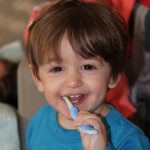
Caries and periodontal disease are two of the world’s commonest diseases, but they are preventable with effective oral hygiene measures. Toothbrushing is a key element of oral hygiene and can be very effective when undertaken regularly and correctly using a manual toothbrush and fluoride toothpaste. It does however require a level of manual dexterity that can be challenging for some individuals particularly children. Numerous types of manual toothbrushes with various handle shapes, head designs and bristle angles are available and recently single- use chewable toothbrushes have been introduced which may be more convenient for children,
The aim of this review was to compare the effectiveness of a chewable toothbrush (CTB) with a manual toothbrush (MTB) in terms of plaque reduction.
Methods
A protocol was published in the Open Science Framework (OSF) and searches conducted in Medline-PubMed, Embase, Cochrane Central Register of Controlled Trials (CENTRAL), SCOPUS and Google Scholar. Randomised controlled trials (RCTs) in children not receiving orthodontic treatment up to the age of 15 years that compared chewing and manual toothbrushes were considered. The main outcome was change in plaque scores reported as mean differences (MDs) and confidence intervals (95%CI). Two reviewers independently screened and selected studies extracted data and assessed risk of bias using the Cochrane Risk of Bias tool (RoB 2.0). The certainty of evidence was assessed using the Grading of Recommendations Assessment, Development and Evaluation (GRADE) approach.
Results
- 7 RCTs (5 parallel, 2 crossover) involving a total of 310 children aged between 8-14 years were included.
- 3 RCTs evaluated single brushing exercises.
- 2 RCTs were considered to be at high risk of bias and 5 RCTs to have some concerns.
- Most RCTs detected no statistically significant difference between treatment groups,
- Meta-analysis (7 RCTs) showed no statistically significant difference between chewable and manual toothbrushes for plaque reduction: –
- MD = −0.04 (95%CI: −0.26 to 0.18)
- with a 95% prediction interval of −0.76 to 0.67.
- The certainty of evidence was assessed as very low.
Conclusions
The authors concluded: –
There is very low-certainty evidence of no significant difference on plaque removal between MTB and CTB in non-orthodontic children. Due to unexplained high heterogeneity and low methodological quality of RCTs we cannot determine the extent to which our finding reflects a true effect or bias arising from limitations of primary studies.
Comments
The authors published a protocol on the Open Science framework and searched a good range of databases. Only 7 RCTs were included, and these were small and of short duration with 3 being single brushing studies. None of these were at low risk of bias so the certainty of the evidence is very low so should be interpreted very cautiously. As the authors suggest future studies should follow the SPIRIT and CONSORT statements . New studies should also be of appropriate size, longer term sand incorporate patient-centered outcomes.
Links
Primary Paper
Oliveira LM, Pelissari TR, Oliveira MDM. Is chewable toothbrush effective in terms of dental plaque reduction in children? A systematic review and meta-analysis of randomized controlled trials. Int J Dent Hyg. 2023 Jan 26. doi: 10.1111/idh.12671. Epub ahead of print. PMID: 36704825.
Other references
Dental Elf – 1st Jul 2020
Dental Elf – 25th Oct 2017
Dental Elf – 17th Oct 2016
Dental Elf – 11th Aug 2014
Picture Credits
Photo by Shalev Cohen on Unsplash
